Blessed Utto | |
|---|---|
 | |
| Born | unknown |
| Died | October 3, 829 Metten |
| Venerated in | Roman Catholic Church |
| Feast | October 6 |
The Blessed Utto was the first abbot of the Bavarian Metten Abbey of the Benedictine Order. His feast is celebrated on October 3.
Blessed Utto | |
|---|---|
 | |
| Born | unknown |
| Died | October 3, 829 Metten |
| Venerated in | Roman Catholic Church |
| Feast | October 6 |
The Blessed Utto was the first abbot of the Bavarian Metten Abbey of the Benedictine Order. His feast is celebrated on October 3.
Utto was presumably a monk at the abbey of Reichenau; his place of birth is unknown. According to tradition he was a relative and the godson of the priest and landlord Gamelbert in the Bavarian community Michaelsbuch, a few kilometers up from the confluence of the river Isar on the right-hand side of the Danube near the modern-day town of Plattling. As Gamelbert founded Metten Abbey on his ground around 766, he is said to have entrusted Utto with the settlement. Utto, who came from Reichenau to Metten together with twelve other monks was appointed the first abbot of the abbey. The name Abbot Utto of Metten appears in 772 in the Verbrüderungsbuch (a German register of medieval abbeys) of the synod of Dingolfing and in 784 in the Verbrüderungsbuch of St. Peter's Archabbey in Salzburg. He died on October 3, 829 in Metten Abbey.
According to late medieval legend, Charlemagne was the founder of Metten Abbey and Utto was a hermit in the woods around Metten. Charlemagne was said to have met him while hunting and to have promised the foundation of an abbey in the honour of Saint Michael on the request of this pious man (after 788). A small church called Uttobrunn was erected in the 17th century at a spring to commemorate the site of this alleged meeting.
Metten Abbey keeps a medieval crosier, that is revered as the staff of Blessed Utto. The crook is carved from walrus tooth to form a dragon encircling a lamb with a banner of victory. From comparison with similar objects it cannot be dated earlier than the beginning of the 13th century, however. The staff itself may be older, as a bronze band below the crook is inscribed with Romanesque majuscules: QVOD DŇS [= Dominus] PETRO, PETRVS TIBI CONTVLIT, VTTO (What the Lord has assigned to Peter, Peter has assigned to you, Utto).
Gilbert Crispin was a Christian author and Anglo-Norman monk, appointed by Archbishop Lanfranc in 1085 to be the abbot, proctor and servant of Westminster Abbey, England. Gilbert became the third Norman Abbot of Westminster to be appointed after the Norman Conquest, succeeding Abbot Vitalis of Bernay.

Reichenau Abbey was a Benedictine monastery on Reichenau Island. It was founded in 724 by the itinerant Saint Pirmin, who is said to have fled Spain ahead of the Moorish invaders, with patronage that included Charles Martel, and, more locally, Count Berthold of the Ahalolfinger and the Alemannian Duke Santfrid I (Nebi). Pirmin's conflict with Santfrid resulted in his leaving Reichenau in 727.
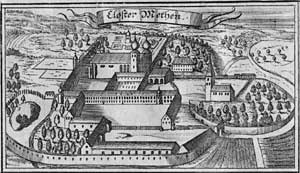
Metten Abbey, or St. Michael's Abbey at Metten is a house of the Benedictine Order in Metten near Deggendorf, situated between the fringes of the Bavarian Forest and the valley of the Danube, in Bavaria in Germany.

The Blessed Gamelbert was a Christian priest, who worked in the 8th century in what is now Deggendorf, Bavaria, Germany.
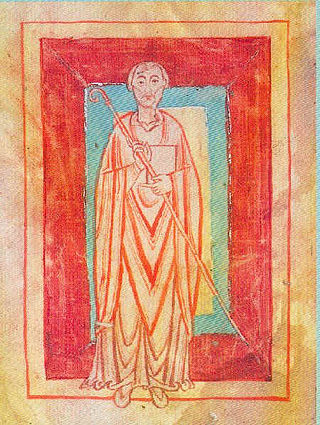
William of Hirsau was a Benedictine abbot and monastic reformer. He was abbot of Hirsau Abbey, for whom he created the Constitutiones Hirsaugienses, based on the uses of Cluny, and was the father of the Hirsau Reforms, which influenced many Benedictine monasteries in Germany. He supported the papacy in the Investiture Controversy. In the Roman Catholic Church, he is a Blessed, the second of three steps toward recognition as a saint.

Ulrich of Zell, also known as Wulderic, sometimes of Cluny or of Regensburg, was a Cluniac reformer of Germany, abbot, founder and saint.
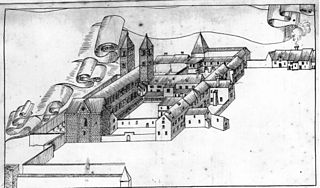
The Scots Monastery is the former Benedictine Abbey of St James (Jakobskirche) in Regensburg, Germany. It was founded in the 11th century by Irish missionaries and for most of its history was in the hands of first Irish, then Scottish monks. In Middle Latin, Scotti meant Gaels, not differentiating Ireland from Scotland, so that the term Schottenstift dates from the Irish period. The full official name of the actual church, the most prominent building within the abbey complex, is Die irische Benediktinerklosterkirche St. Jakob und St. Gertrud.
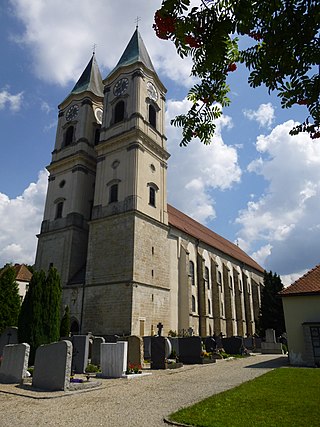
Niederaltaich Abbey is a house of the Benedictine Order founded in 741, situated in the village of Niederalteich on the Danube in Bavaria.

Arbeoof Freising was an early medieval author and the Bishop of Freising from 764.
Diemoth was a recluse at Wessobrunn Abbey in Upper Bavaria, Germany, born around 1060 and died on 30 March, probably in 1130. She worked on 45 manuscripts from 1075 to 1130. Her name comes from the Middle High German word for "humility" or "modesty")
Waldo of Reichenau was an abbot and Carolingian official.

Elisabeth of Schönau was a German Benedictine visionary. She was an abbess at the Schönau Abbey in the Duchy of Nassau, and reportedly experienced numerous religious visions, for which she became widely sought after by many powerful men as far away as France and England.
Eigil was the fourth abbot of Fulda. He was the nephew and biographer of the abbey's founder and first abbot Saint Sturm. We know about Eigil primarily from the Latin Life that the monk and teacher of Fulda, Candidus Bruun composed about him after his death.
Wolfhelm of Brauweiler was the Benedictine abbot of Brauweiler Abbey, near Cologne, Germany.

Heinrich Held was a German Catholic politician and Minister President of Bavaria. He was forced out of office by the Nazi takeover in Germany in 1933.
Saint Sturm, also called Sturmius or Sturmi, was a disciple of Saint Boniface and founder and first abbot of the Benedictine monastery and abbey of Fulda in 742 or 744. Sturm's tenure as abbot lasted from 747 until 779.
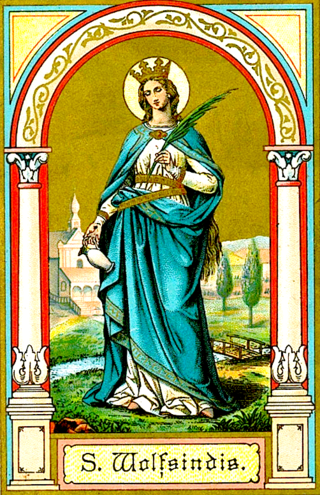
Wolfsindis of Reisbach is a regional saint of the Middle Ages in Lower Bavaria, who is revered as holy virgin and martyr. Her veneration dates back to the 7th or 8th century.
Saint Burchard of Meissen was the first Bishop of Meissen, from 968.

Arnold of Arnoldsweiler (died c. 800 in Ginnizweiler, today Düren-Arnoldsweiler) is a saint of the Roman Catholic Church, Orthodox Church and True Orthodox Church and was a musician at the court of Emperor Charles the Great, known as Charlemagne. His feast day is 18 July.
Matthias or Mathias Schraudolph was a German painter and Benedictine monk in Metten Abbey under the religious name Frater Lucas OSB.